
Exihibition at the Gallery Isabelle van den Eynde (7 Nov – 30 Dec, 2017) :mentalKLINIK - Truish
Nov 23, 2017 Exhibition

:mentalKLINIK’s second solo exhibition is on view at the Gallery Isabelle van den Eynde in Dubai. 'Truish' not only presents an ambiguous scenario, but also asks a pertinent question: What is the truth? How does one gauge the truthiness of something? What you see in this exhibition is perhaps true – or maybe not, and this ambiguity becomes the fuel to question our reality and surroundings.
With a keen interest in invisible politics and dynamics that shape our everyday lives, :mentalKLINIK reveal awkward, alien and surreal elements into the exhibition space. Such is the case in the neon work 'Are You Popular Enough?' that sees an overlapping of their handwritings to challenge the existence of their duo and creates a fuzzy understanding of how much is enough to achieve complete satisfaction. The artists do not attempt to remind us of the regular or the normal, instead they create an uncanny and overwhelming environment that takes a jab at reality (and art) by navigating a slippery slope that is the ‘truth’. This echoes in the non-serious, pastel coloured frames around covers of the prestigious Time magazine, which are overlaid with cheaply produced stickers and popular Emojis to generate multiple layers and surfaces. By manipulating the aesthetics of a credible source of information in this manner, these personalised covers raise an eyebrow on accountability and political strategies.
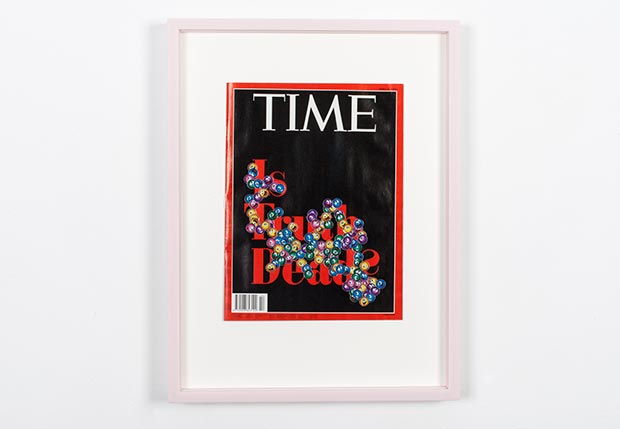 :mentalKLINIK, Some-Time 1704, 2017, Time magazine issues, stickers and artist's frame in acrylic resin and natural minerals, 43 x 33 cm / Courtesy the artists and Gallery Isabelle van den Eynde
:mentalKLINIK, Some-Time 1704, 2017, Time magazine issues, stickers and artist's frame in acrylic resin and natural minerals, 43 x 33 cm / Courtesy the artists and Gallery Isabelle van den Eynde
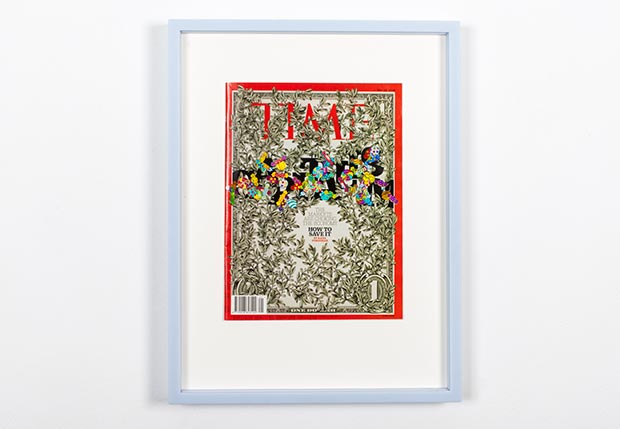 :mentalKLINIK, Some-Time 1712, 2017, Time magazine issues, stickers and artist's frame in acrylic resin and natural minerals, 43 x 33 cm / Courtesy the artists and Gallery Isabelle van den Eynde
:mentalKLINIK, Some-Time 1712, 2017, Time magazine issues, stickers and artist's frame in acrylic resin and natural minerals, 43 x 33 cm / Courtesy the artists and Gallery Isabelle van den Eynde
 :mentalKLINIK, Installation view / Courtesy of Gallery Isabelle van den Eynde
:mentalKLINIK, Installation view / Courtesy of Gallery Isabelle van den Eynde
The truth can be fickle in the age of Internet and digital reproduction, and Phony skilfully brings this into the rhetoric. The round clear glass works embedded with solar film allow visitors to indulge in an involuntary performance as the colours of the work change with the viewer’s orientation. This performative element is also evident in 'Chromatic Madness', where the artists carry out physically strenuous activities such as crushing, rolling and flattening to temper with a dichroic film. In doing so, :mentalKLINIK allude to Josef Albers’ playful informality of relying on one’s body and easily available material to create works that take the preciousness out of art. The minimalist 'Self-Seeking Superficials' also draw inspiration from Albers’ colour interaction theory where the American-German artist explores how different colours behave with each other. :mentalKLINIK thus overlay brightly coloured polyester solar films and create multiple spaces where the background, the object and the subject are visible at once. The viewer sees their distorted and sublimated self reflected into the work that conforms to the underlying notions of being manipulated in the digital age.
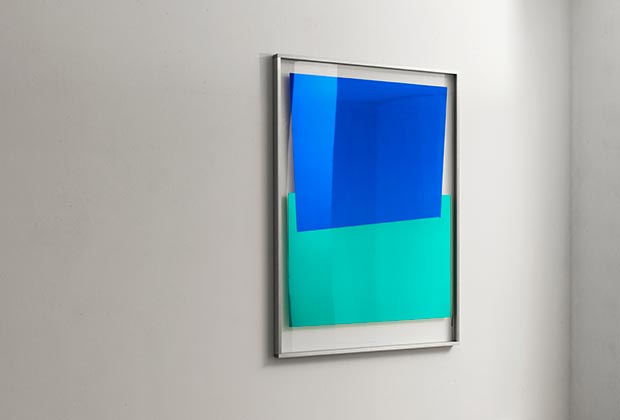 :mentalKLINIK, Self-Seeking-Superficials 1705, 2017, Ultra-clear tempered glass, micro-layered polyester solar films and artist’s frame in eloxal coated aluminium, 121.5 x 91.5 cm / Courtesy the artists and Gallery Isabelle van den Eynde
:mentalKLINIK, Self-Seeking-Superficials 1705, 2017, Ultra-clear tempered glass, micro-layered polyester solar films and artist’s frame in eloxal coated aluminium, 121.5 x 91.5 cm / Courtesy the artists and Gallery Isabelle van den Eynde
 :mentalKLINIK, Self-Seeking-Superficials 1707, 2017, Ultra-clear tempered glass, micro-layered polyester solar films and artist’s frame in eloxal coated aluminium, 121.5 x 91.5 cm / Courtesy the artists and Gallery Isabelle van den Eynde
:mentalKLINIK, Self-Seeking-Superficials 1707, 2017, Ultra-clear tempered glass, micro-layered polyester solar films and artist’s frame in eloxal coated aluminium, 121.5 x 91.5 cm / Courtesy the artists and Gallery Isabelle van den Eynde
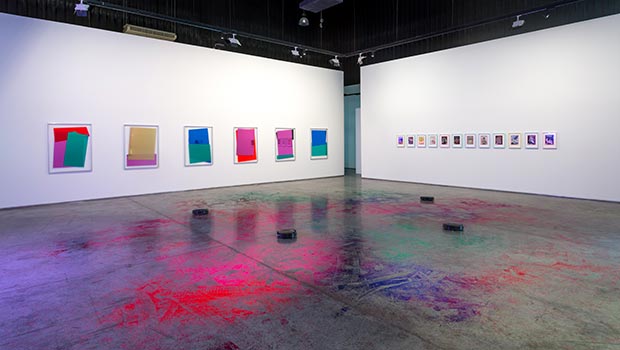 :mentalKLINIK, Installation view / Courtesy of Gallery Isabelle van den Eynde
:mentalKLINIK, Installation view / Courtesy of Gallery Isabelle van den Eynde
At the centre of the exhibition is 'Puff Out', a new version of their earlier installation 'PuFF', which was first shown at Art Unlimited, Art Basel in 2009 and “attempts to create an unidentified space, an indecisive zone and frozen time establishing various relations with materials and actions, which construct an immaterial world.†This idiosyncratic installation almost imitates a theatrical set, where its actors (the robots) go backstage (charging units) to be able to indulge in another day of performance of collecting and discarding sparkling glitter. In doing so, the visitors become just as much part of the performance when they have to navigate the exhibition space around the movement of the vacuum cleaners, which create a constantly changing ‘painting’ on the floor.
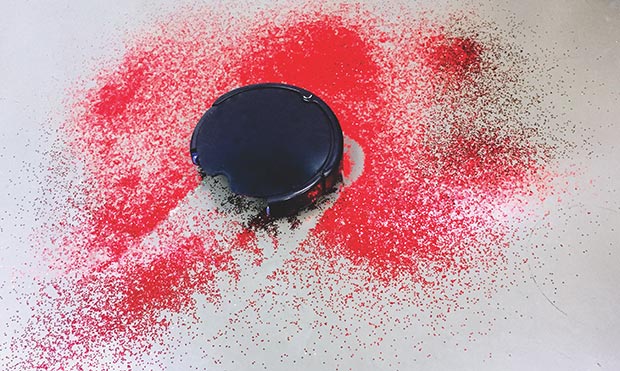 :mentalKLINIK, Puff Out, 2017, 4 vacuum cleaning robots and glitter, Robots: 34 cm diameter and 6 cm thickness, Glitter: variable / Courtesy the artists and Gallery Isabelle van den Eynde
:mentalKLINIK, Puff Out, 2017, 4 vacuum cleaning robots and glitter, Robots: 34 cm diameter and 6 cm thickness, Glitter: variable / Courtesy the artists and Gallery Isabelle van den Eynde
The dark, sparkling glitter has its own nature of movement and opens up infinite possibilities of creation. Similarly, the video 'Whiff' plays with the viewer’s perception of time by blurring the boundary between the real and virtual, motion image and painting, with 4 seconds of action time-lapsed into the 3 minute 4 second video. “While confetti is a symbol of celebration, this video celebrates a void where the audience is left suspended somewhere between the poetic and political connotation of a therapeutic visual.â€
 :mentalKLINIK, Whiff, 2010, Single channel video, colour, no sound. Duration: 3 minutes and 4 seconds (M/VI 005) / Courtesy the artists and Gallery Isabelle van den Eynde
:mentalKLINIK, Whiff, 2010, Single channel video, colour, no sound. Duration: 3 minutes and 4 seconds (M/VI 005) / Courtesy the artists and Gallery Isabelle van den Eynde
Duality – or lack thereof – is a core aspect of this exhibition, where the objects become whimsical failures that cannot uphold their truthfulness, and leave us wondering about what we see and what we perceive. :mentalKLINIK’s works are not only layered with questions about popular culture, but also allow us to explore new ways of looking by constantly challenging our perception.
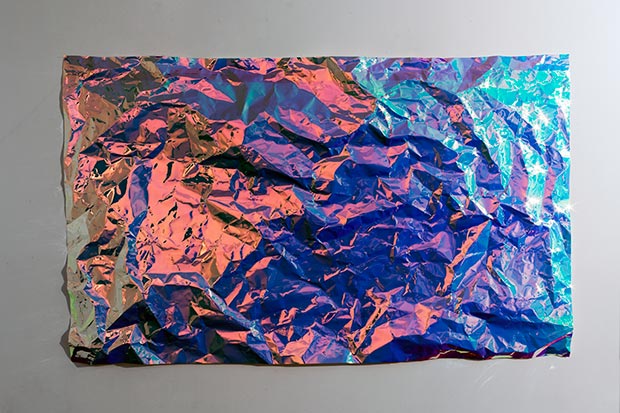 :mentalKLINIK, Chromatic Madness 1706, 2017, Cotton paper and dichroic micro-layered polyester solar film, 149 x 108 cm / Courtesy the artists and Gallery Isabelle van den Eynde
:mentalKLINIK, Chromatic Madness 1706, 2017, Cotton paper and dichroic micro-layered polyester solar film, 149 x 108 cm / Courtesy the artists and Gallery Isabelle van den Eynde
 :mentalKLINIK, Installation view / Courtesy of Gallery Isabelle van den Eynde
:mentalKLINIK, Installation view / Courtesy of Gallery Isabelle van den Eynde
:mentalKLINIK is a Brussels-based artist duo from Istanbul composed of Yasemin Baydar (born 1972, Istanbul) and Birol Demir (born 1967, Ankara) who began their collaborative practice in 1998. The duo’s theory and practice is not meant to explain one another, instead they create a new individuality to produce works that shift between emotional and robotic attitudes. :mentalKLINIK has a reactionary, open laboratory approach to process, production, roles, conception and presentation. This vocabulary gives their work a relationship with different references and background. Their work is a mix of oxymora and paradoxes, darkly humorous, selfcontained and as much concerned with the total effect of accelerated capitalism as with the invisible politics and dynamics that define our everyday lives. :mentalKLINIK’s oeuvre is droll and can look very playful and fun but at the same time, it is violent, abrasive and very questioning of the world we live in. Eschewing themes of identity, history and memory, their works range from immersive time based installations to sculptures and objects that thwart categorisation.
Comments
Add a comment